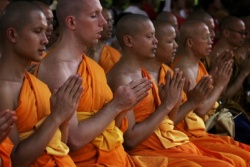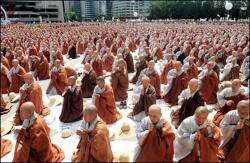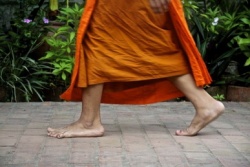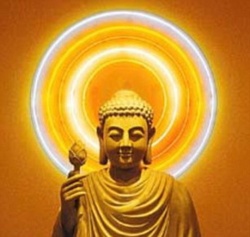Taking Refuge
by Yukhok Chatralwa Chöying Rangdrol
This has two sections:
1) causal and resultant refuge, and
2) how to take refuge.
1. Causal and Resultant Refuge
The commentary to Finding Comfort and Ease in the Nature of Mind says:
In this regard, according to the vehicle of characteristics, the wish to attain the ultimate dharmakaya and realize it in one’s mind is the resultant refuge, and to take refuge in the Three Jewels as one’s guides until this has been attained, thus creating the cause for its attainment, is the causal refuge.
And:
The followers of the secret mantra tradition seek to realize directly the nature of their own mind, which is innate buddhahood, present even now, and then they take refuge in the common sources of refuge, the outer Three Jewels, and, in the uncommon refuge, by resting in the nature of mind, which is, and always has been, unborn.
Thus, the Three Jewels of the various mandalas and the Three Jewels of the teachings in general are the causal sources of refuge, and taking refuge in them is the causal refuge. The resultant source of refuge is the nature of one’s own mind, naturally arising wisdom, in which the Three Jewels have always been present, and to rest in this nature, one-pointedly, without acception or rejection or any kind of fabrication or contrivance, is the resultant refuge.
The fundamental nature of the mind itself has always—throughout time immemorial—been the nature of the resultant Three Jewels. If, through the kindness of the causal Three Jewels, we can awaken this potential and realize it for ourselves, then our minds will be easily and swiftly afforded protection and all our conceptual thoughts will be released by themselves in the fundamental expanse of clear light, without any opportunity for creating habitual tendencies.
2. How to Take Refuge
The Character of the Objects of Refuge
In the Three Jewels, and their essence, the sugatas,
In the three roots: lama, yidam and khandro,
In the channels, inner air, and tiklés, and their nature, the bodhichitta,
In the mandala of essence, nature and compassion,
I take refuge until enlightenment is fully realized.
In the tradition of the common vehicles, we consider the buddhas who possess the four kayas and five wisdoms as our guides, the Dharma which has aspects of both transmission and realization as our path, and the irreversible sangha who have the qualities of knowledge and liberation as our companions as we practise along the path. We take refuge in them with the wish that in future we will actually accomplish these three for ourselves.
According to the general method of the uncommon secret mantra, we take refuge in the ‘three roots’ in addition to the buddhas who have perfected abandonment and realization. We offer our body, speech and mind to the lama, who is the source or ‘root’ of all blessings. We rely upon the yidam deities, who arise in infinite peaceful and wrathful forms out of the peaceful state of the dharmakaya, and are the source of all siddhis. We take as our companions the wisdom dakinis, who course unimpededly throughout the unborn space of reality through the force of unceasing compassion, and are the source of eliminating obstacles.
According to the special, sublime method of the Vajra Essence, we take refuge in the swift path whereby, we use the great vital essence of the channels as the nirmanakaya, as a support for attaining the enlightenened body; we train the five indestructible wind-energies as the sambhogakaya, as a support for attaining the enlightened speech; and we purify the nature of the subtle essences as the dharmakaya, as a support for attaining the enlightened mind.
In this special approach of the vajra body’s channels, energies and essences, the coarse and the subtle channels, wind-energies and essences, together with any impurities, arise due to the dynamic energy of the great tiklé of clear light, within which the ‘supported’ experience of unchanging great bliss and the great emptiness that is endowed with the supreme of all attributes are inseparably united.
If we apply the method the pure experience of primordial wisdom will dawn, but if we do not practise, the impure experiences of delusion will arise. For this practice to take effect, it is crucial that you learn the nature of the vajra body as it is taught in the tantras, commentaries and pith instructions.
The ultimate and infallible refuge in the natural state involves cultivating the great ultimate mandala of the naturally arisen non-dual wisdom that is present within the minds of the sources of refuge, the bodhichitta consisting of the empty essence, which is the dharmadhatu or emptiness endowed with the supreme of all attributes, the spontaneously perfect wisdom of the cognizant nature, and the wisdom of all-pervading compassion. Moreover, the empty essence is the dharmakaya, guru and Buddha; the cognizant nature is the sambhogakaya, yidam deity and Dharma; and the all-pervasive compassion is the nirmanakaya, dakini and sangha.
Some people might wonder whether or not the extraordinary, uncommon sources of refuge found in the secret mantra can be included within the Buddha, Dharma and Sangha. In fact, they are included in the following way.
The guru could either be an ordinary being or an Arya, so he or she is either a member of the sangha or included among the buddhas. In a general sense, we can say that the yidam deities are alike in being embodiments of primordial wisdom, yet they appear in peaceful or wrathful forms according to the nature of their manifestation, and therefore they are included within the Buddha jewel. The dakas and dakinis are to be included among the inner sangha of vidyadharas, as is stated clearly in the Tantra of Yamantaka and other texts.
The reason these three are spoken of separately as the ‘three roots’ is as follows. Although, in general, the gurus might be included among the buddhas or the sangha, the particular guru who grants us the instructions which mature and liberate is exceptionally kind, and therefore we take refuge knowing that he or she is the ‘root’ or source of blessings.
Although all the peaceful and wrathful yidam deities are included among the buddhas, we consider as special the deity on whose symbol our flower alights during an empowerment and with whom we have a karmic connection from our former lives, recognizing him or her as the source of all accomplishments. Although we take refuge in all the dakas and dakinis knowing that they belong to the inner sangha of vidyadharas, we make special offerings to those who are particularly close to us, acknowledging that they are the source for the elimination of obstacles.
Consider that you take refuge with the attitude of a great being, from now until you attain unsurpassable enlightenment.
Visualization of the Field of Merit for Taking Refuge
Imagine that the whole area where you are seated and in all surrounding directions is a beautiful and heavenly realm, made from various precious jewels. From the ground there grows a wish-fulfilling tree with five main branches. It is laden with abundant leaves, flowers and fruit, and decorated with hanging ornaments, tiny bells and such like. It fills the whole expanse of space. In its centre, upon a jewelled throne supported by lions and seats of multi-coloured lotus, sun and moon, is the embodiment of all the buddhas—your own root master—in the form of Orgyen Dorje Chang (‘the Vajradhara of Oddiyana’), who is blue in colour and holding vajra and bell.
(Note: Shabdrung Rinpoche[1] used to say that to consider Guru Rinpoche as blue in the refuge practice accords with the oral tradition of the Omniscient One [i.e. Jigme Lingpa) himself. As it says in Secret Embodiment of the Guru, Lama Sangdü:
“Dark blue, with one face and two hands, naked, with three eyes and bone ornaments, his right hand holding a vajra at his heart, and his left hand holding a bell and embracing the consort. He is seated with his two feet in the vajra posture. The consort is seated in his lap to the left side. She is the wisdom dakini Yeshe Tsogyal, in the full beauty of a sixteen-year old youth.”
He is in union with his consort, Yeshe Tsogyal, who is white and holding a hooked knife and skull-cup. They are adorned with silk and bone ornaments.
The Guru is seated in the vajra posture. Above his head are the masters of the Dzogchen lineage, seated one above the other. They are surrounded by the root and lineage masters, the yidam deities of the various mandalas associated with the six great classes of tantra, and an inconceivable number of dakas and dakinis of the three spheres.
On the branch in front are Shakyamuni Buddha and all the other buddhas of the three times, in nirmanakaya form. On the branch to the right is the Mahayana sangha, including the Eight Close Sons. On the branch to the left are Shariputra and Maudgalyayana, and the assembly of the noble sangha of shravakas. On the branch at the back is the Jewel of the Dharma in the form of stacks of books, red in colour, from which the vowels and consonants resound by themselves.
In the space in between, there is a great ocean-like gathering of samaya-bound guardians, both those of wisdom and those in forms brought about by their own past actions. They fill the whole area, without leaving any gaps.
‘Those in forms brought about by their own past actions’ refers to protectors such as the twenty-eight ishvari,s, who transcend the world and yet still appear in worldly forms created by their past karma and disturbing emotions like ordinary worldly beings. For example, when [[Vajra Manushy] Rakshasi]] was the wife of Ravana, king of the Rakshasas, she had the face of a rakshasi, but then when she was abducted by Rudra, she transformed her rakshasi face into that of a yak.
Consider how all these deities have immeasurable qualities of wisdom, love and power, and are actually present as great guides who care for you and lead you along the path to enlightenment.
You are seated before them with your father on your right and your mother on your left. In front of you are all the beings who have ever caused you harm; and in the whole surrounding area are all the sentient beings of the six realms. You all show respect with your body by folding your hands together; with your speech, you all chant resoundingly the verse for taking refuge; and with your mind, you think the following:
“From now until we realize the heart of enlightenment, we take the master as our guide, the yidams and buddhas as our teachers; the Dharma as our path; and the dakinis, Dharma protectors and members of the sangha as companions along the way. We rely on you. We offer everything to you. We have no other refuge or hope but you. Whatever we do, take care of us.”
Practice taking refuge with fervent devotion in this way as many times as possible.
At the end, rays of light stream out from the hearts of the refuge deities. They enter your body and mind, and those of all other beings, and purify your emotional and cognitive obscurations and habitual patterns. Consider that your life span is extended, your merit increases, and your qualities of learning and realization develop further and further. Rest in meditation for a while in a state that is free from any mental grasping.
Alternatively, according to Patrul Rinpoche’s Brief Guide to the Stages of Visualization:
At the end of the session consider that you and all the other beings fly up with a whirring sound, like a flock of birds scattered by a sling-stone, and dissolve into the assembly of refuge deities.
Then the refuge gradually melts into light. In front, the buddhas all dissolve into Shakyamuni. To the right, the bodhisattvas all dissolve into Avalokiteshvara. To the left, the noble sangha of shravakas and pratyekabuddhas dissolves into Shariputra. They all dissolve into the Dharma at the back, and then this entire Jewel of the Dharma dissolves into Guru Rinpoche. All the surrounding masters, yidams, Dharma protectors and guardians also dissolve into Guru Rinpoche who then dissolves slowly into the light and disappears. Rest for a short while in a state that is free from conceptual reference.
This is said to be the absolute refuge, or the ultimate resultant refuge according to the mantrayana. Mipham Rinpoche said:
At the end of the session, consider that the sources of refuge melt into light and dissolve into you and all other beings, through which you all become buddhas. Then dedicate the merit.
The precepts and benefits may be understood from other sources.
| Translated by Adam Pearcey, Rigpa Translations, 2006 (revised 2012). Thanks to Ringu Tulku Rinpoche for his clarifications.




